|
We are fortunate to be able to share with you some views and
memories from the early 1920s of Kingscote station. This page
features some of the staff who worked at the station during the
period, while historic views of the station and its environs are
on this separate page.
Our collection of photographs are copies of those taken by
Leonard (Len) Mead, son of the Kingscote Stationmaster at the
time. Len developed and printed these photographs in a makeshift
darkroom in the cupboard under the stairs of the station house.
He visited the station with his sister during its restoration in
1987 and continued to visit until his deat h in 1993. His ashes
lie under an apple tree planted in his memory in the station
garden.
Len is shown here at Kingscote in a contemporary view. As he
scratched his name across the back of the negative, the photo was
printed in reverse. He is, in reality, standing at the south end
of the up platform, with the up home signal and the chimneys of
the railway cottages in the background.
|
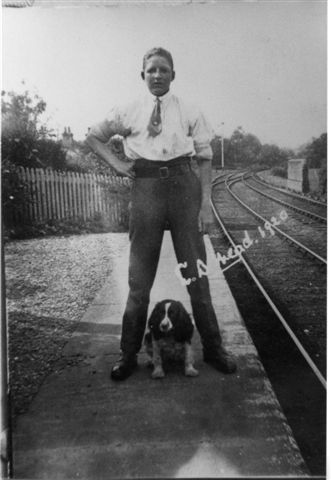 |
 |
The Stationmaster
William George May Mead (Len's father) moved to Kingscote from
Hever in 1915. He had started in the signal box at Clapham
Junction and moved on to Victoria where he became Chief Clerk. He
first became station master at Wivelsfield and his next post was
at Hever. After his tenure at Kingscote, Mr Mead went on to
Emsworth (near Portsmouth) and finished his career at the Parcels
Office at Brighton.
A Stationmaster was a man worthy of respect in the community,
expected to set an example to passengers and staff. He therefore
wears full uniform. Note the heavy boots worn even by the
Stationmaster and the chain for a pocket watch. In the 1920s
wristwatches were rare and expensive, and unsuitable in manual
industries such as railways. The informality possible at a quiet
station like Kingscote is perhaps shown by the cigarette Mr Mead
has not quite hidden in his hand while he has his photograph
taken.
Mr Mead was the last Stationmaster, since when he moved on in
1926 Kingscote came under the control East Grinstead, an early
foretaste of future economies.
|
|
The Booking Clerk
Charlie Browning stands by the Station porch at Kingscote. The
stained glass panels and carved pilasters did not stand up well
to the Sussex weather and were replaced by wooden boarding at all
stations on the line. Clerks were not issued with a uniform.
Charlie had started at West Hoathly but, according to Len, had
not 'settled down' there. Stationmaster Mead saved the situation
by having him moved to Kingscote under closer supervision.
Charlie stayed on the railway until his retirement circa 1970
from his position as Assistant Chief Clerk in the booking office
at Brighton.
|
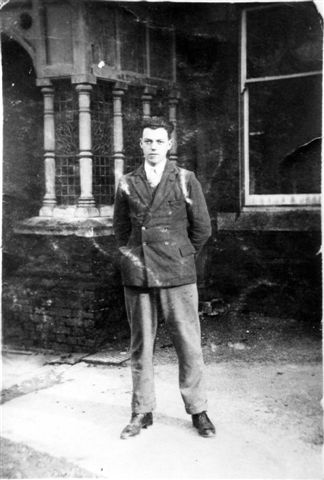
|
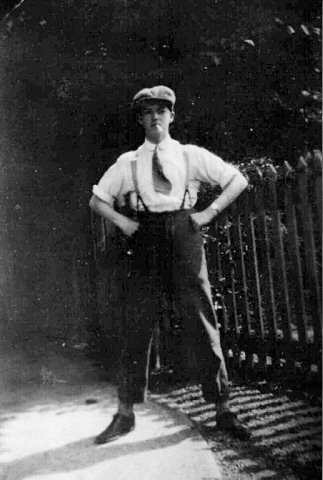
|
Charlie Browning is shown in this view, captioned by Len as a
"learner clerk". He is doubtless wearing what the smart young man
of the 1920's was wearing at the time! We originally believed the
location to be at the south end of the up platform, but now (due
to the presence of the large plant pot and the return in the
fence) we consider that it is outside the entrance to the station
house.
|

|

Alfred James Hillman, Porter–Signalman
Alfred lodged with the Mead family in the station house; his
own family (father, James and mother, Nellie) lived at 13
Highlands, Cuckfield. Families frequently took in a paying lodger
who was often treated, as Alfred was, like one of the family.
Alfred (born 1899) befriended the younger Len Mead (born 1900)
and appears in two further photographs.
Porter Signalman was a job common at small stations when the
infrequent train service did not warrant either a full-time
signalman or a porter. It was a stepping-stone between the
general labouring duties of a porter and the more responsible
position of full-time signalman at a busier station. Alfred later
moved on to become signalman at Arundel Junction.
Alfred wears the regulation 'sleeved waistcoat' supplied to
railway staff until the 1970s. He carries a paraffin-lit handlamp
which was used to give signals to a guard or driver at night; it
could show white, red or green by turning the top to bring
coloured glass between the flame and the lens. He is standing in
front of the door to the Porters' Room Room. The section of tree
trunk at the left was for chopping kindling wood on. The rag
hanging on the nail was to wipe one's hands on, as there was no
running water in the Porters' Room – water having to
be brought from the pumphouse in a bucket or churn.
|
The photo below left shows Alfred on the steps of Kingscote
signalbox at the northern end of platform two. The sawmill and
its rail connections can be seen in the background.
Below right, Alfred proudly displays his First World War medal
ribbons. One is the the British War Medal 1914–1918 (the
campaign medal); another is the Allied Victory Medal, while the
third is the Military Medal (a gallantry medal), awarded to him in
1918 for 'Bravery in the Field' during his service on the Western
Front in France or Belgium in the 6th Battalion, West Yorkshire
Regiment. He had been conscripted on 26th November 1917 (conscription
having been introduced in 1916) and was discharged on 16th March 1919.
Conscripts were often sent to regiments with little apparent
connection with their home.
Len Mead told us that the Military Medal was awarded for
Alfred's actions in covering a retreat by firing his Lewis
(machine) gun until the ammunition was used up and only then
'running like hell' after his comrades! The photograph was taken
only a few years after the end of what was then called the 'Great
War' – in which nearly 750,000 young British men had died
and many more been maimed, gassed or mentally injured by 'shell
shock'.
Note Alfred's 'LB&SCR Porter' cap badge, with number to
identify the member of staff.
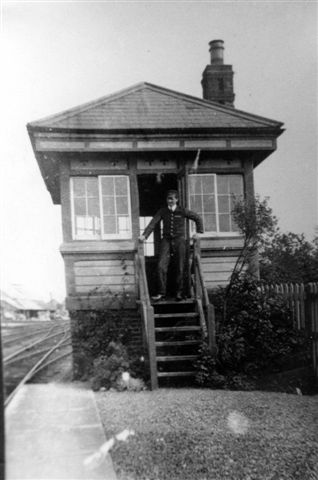
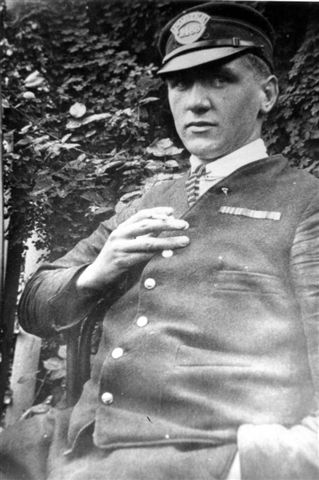
|
William Parker, Porter–Signalman
William was another Porter Signalman like Alfred Hillman. Len
described him as 'a bit religious'. Born in 1886, he started his
railway career in 1910 at Barnham Junction, moving to Kingscote
five years later. He originally lived in one of the pair of
station cottages (located in the lane just south of the station)
but moved into the station house when Stationmaster Mead and his
family moved away in 1926. He soon also took on the duties of
booking clerk as the station's trade no longer justified a
separate clerk. William Parker retired in October 1951, after 36
years in the same job at the same location.
|
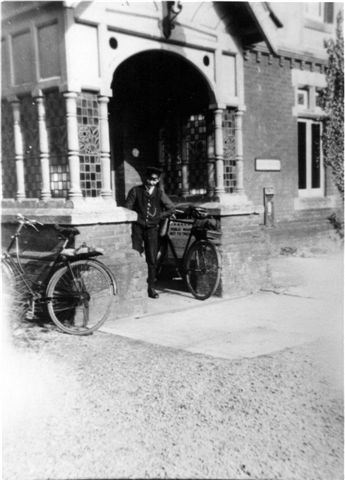 |
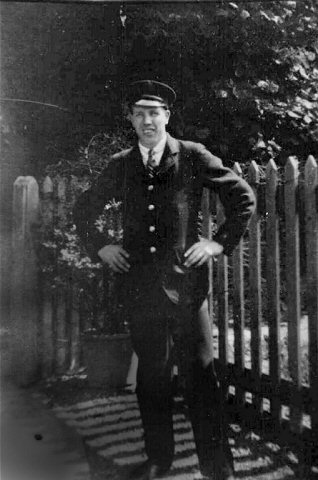 |
William Thorpe, Porter–Signalman
William (Bill) Thorpe was a Porter Signalman (according to
Len's caption) "in the last few years at Kingscote". We know very
little about him, except that he moved on to Angmering station as
a Signalman and was known to be there between 1947 and 1960. Bill
is shown, probably once again outside the entrance to the station
house, wearing the contemporary uniform of the Southern
Railway.
If you know of any further information on the railway career of
Bill Thorpe, or any of the other staff shown in these
photographs, we would be pleased to learn it.
|
|
The Ganger
'Pedlar' Miles was the 'Ganger' responsible for the 'gang' of
men who maintained the track at Kingscote and for a mile or two
either side. Short in stature, his stride was not long enough to
comfortably step from one sleeper to the next when walking his
'length' of track each morning. His solution was to walk on the
top of the rail with a stick to balance him. He lived in the
other railway cottage at Kingscote, next to William Parker. He is
shown standing in front of the door to the station coal
store.
|
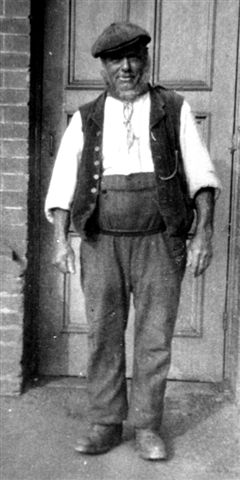 |
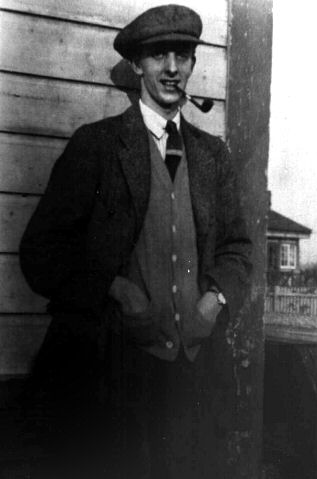 |
The Odd Shot
Len's caption for this view reads: "The picture just shows the
end of the Goods Shed. The man in the photo was the (6ft 4ins
tall) son of the Stationmaster at Dormans station. Just a pal of
mine." We do not know the name of the man, but 6ft 4ins was
extremely tall for the 1920s. If you know of any further
information on him, we would be pleased to learn it. Other items
of note in this view are the end of the original signalbox and
the roses trailing through the paling fence of the up
platform.
|
|



















